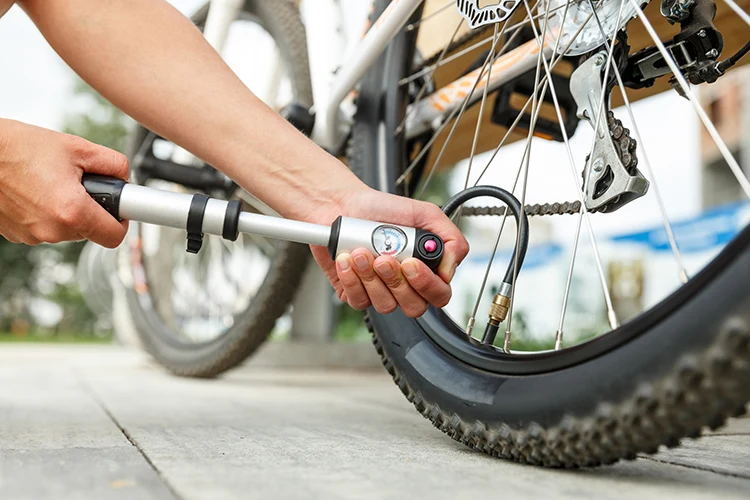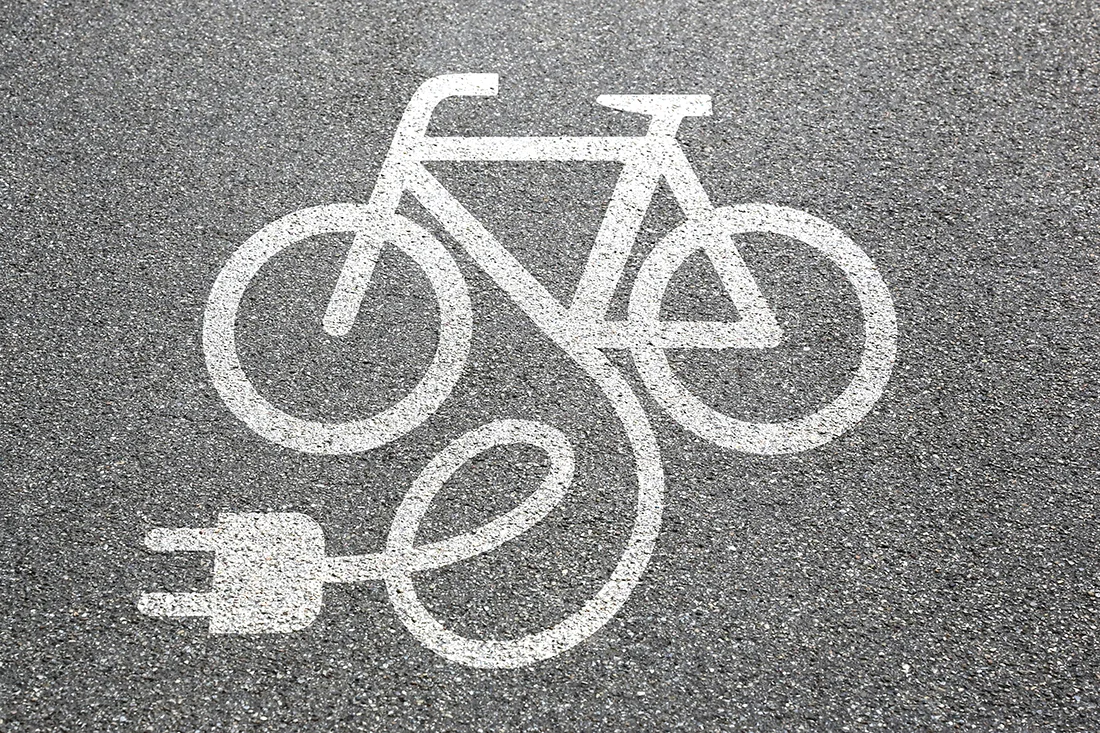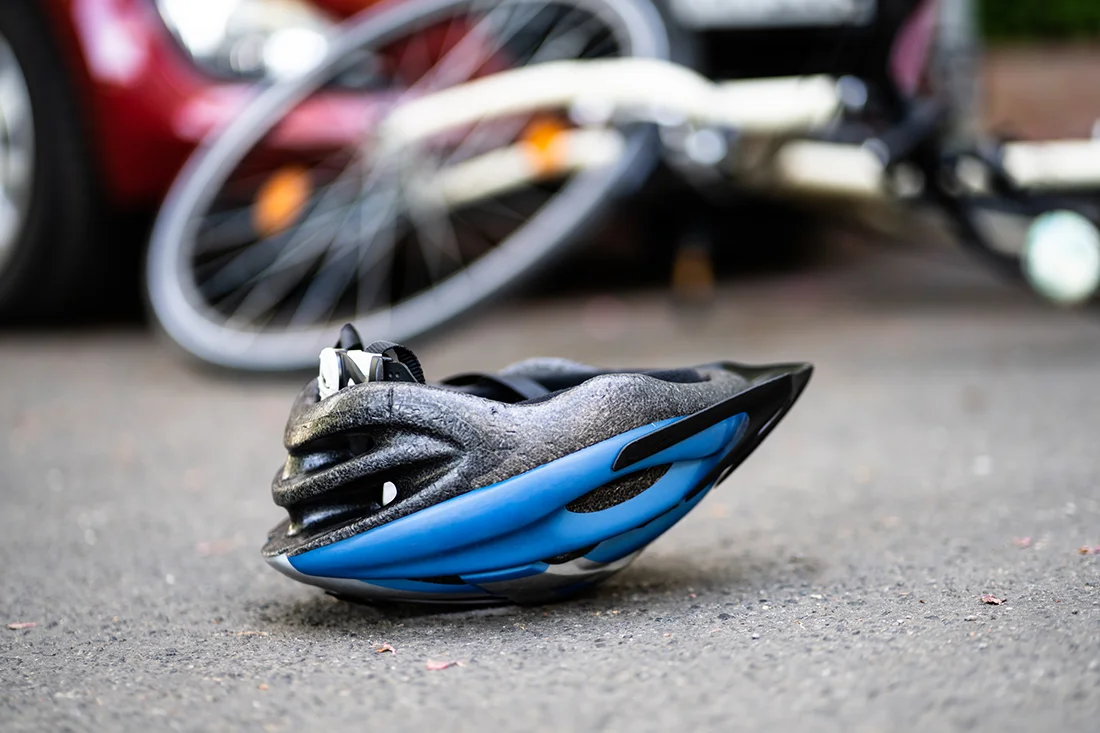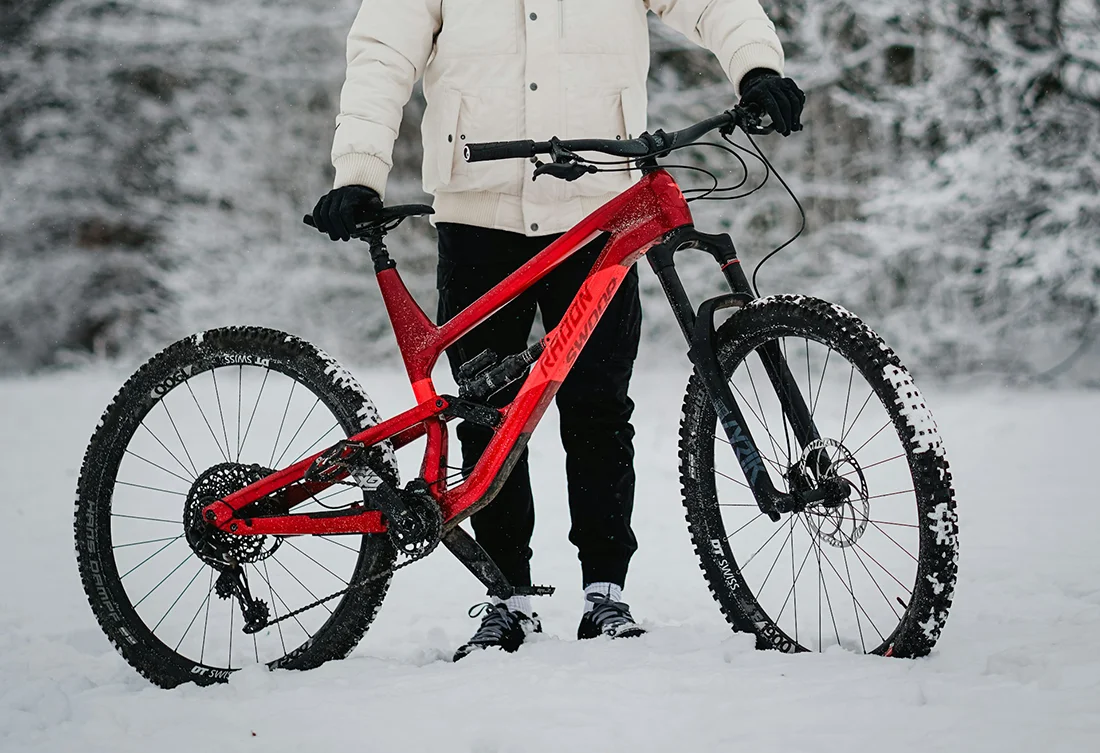Bike tire pressure is one of the most important parts of riding a bike. Without air in the tires, you cannot ride. And without a proper pump, you’ll never make it out the door.
While terms like ‘tire air pressure’ and ‘psi for bike tires’ may sound intimidating, they are quite simple once you break them down.
This is everything you need to know about bike tire pressure.
Contents
What Should My Bike Tire Pressure Be?
Every tire has the ideal pressure range printed on the side, which you should follow closely. It’s important not to ride your bike with tires inflated below or above these ranges.
If you are a light rider, inflate your tires closer to the lower end of the range; and if you are a heavy rider, inflate your tires closer to the higher end of that range.
Moreover, if you want to improve traction (such as in wet weather or on soft surfaces), lower the pressure more than usual and inflate it higher than usual if the weather is dry and you’re riding on a smooth and flat surface (such as tarmac).
Here’s a rough guide in the form of a tire pressure chart for road, mountain, gravel, hybrid, and kids’ bikes.
| Bike Tire Type | Tire Pressure Range (PSI) |
| Road Bikes | 80 – 110 PSI |
| Mountain Bikes | 20 – 30 PSI |
| Gravel Bikes | 30 – 70 PSI |
| Hybrid Bikes | 40 – 80 PSI |
| Kids’ Bikes | 20-40 PSI |
You can also use an online tire pressure calculator to find the ideal settings. But, if you want to go into more detail and find out why tire pressure is so important and how to fine-tune it, we’ll explain everything below.
Road Bike Tire Pressure

Most road bikes have a recommended bike tire psi between 80 and 100 psi, which assumes an average-sized rider around 150-160 lbs. Heavier riders should use slightly higher tire pressures (5-10 psi more) whereas lighter riders can go with slightly lower tire pressures (5-10 psi less).
Tire psi also depends on the type of tire, and when it comes to road bike tire pressure, there are a few different options. Tubeless and tubular tires can operate at lower tire pressures (as low as 65-75 psi) on the road because of their unique construction and lower risk for a pinch flat.
Clinchers, on the other hand, have a higher ideal tire pressure around the typical road bike tire’s 80-100 psi recommendation.
We never recommend straying outside a tire’s recommended psi. But still, you can experiment within that window to find out what’s best for you. Remember that the bumpier the road, the lower the ideal tire pressure.
Same thing for wet conditions – a lower tire pressure (e.g. 80 psi) will help improve your cornering and handling, especially on rough surfaces. Even if it means sacrificing a tiny bit of straight line speed.
Lastly, wider tires can operate at a lower psi with less risk of bottoming out or pinch flats. This is because wider tires have more volume inside the tire, which helps dissipate a heavy impact that could cause a flat tire.
For example, a 23mm road tire may have an ideal tire pressure of 95 psi. And a 32mm road tire may have an ideal road tire pressure of 85 psi in the same exact conditions.
Mountain Bike Tire Pressure
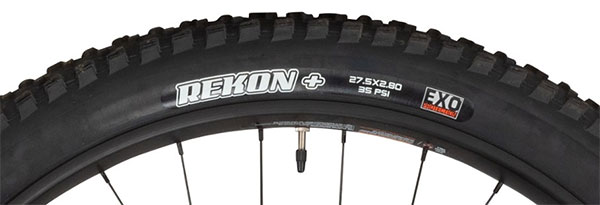
Mountain bike tire pressure follows many of the same guidelines as road bike tire pressure, but at a much lower psi. These tires typically measure between 2.1” and 2.5” wide, making them more than twice as wide as most road bike tires.
The correct tire pressure for mountain bike tires can range from about 20-30 psi. It might fall slightly outside that range in extreme cases (e.g. a very wide tire in wet conditions). Moreover, tubeless tires can be inflated to a lower pressure, which is one of the main benefits of tubeless setups.
Psi for mountain bike tires depends on a number of factors such as the width of the tire, rider weight, trail conditions and terrain, and your riding goals.
Wider tires can handle lower pressures without compromised handling and without a bigger risk of a puncture. Heavier riders can ride with higher tire pressures. Lighter riders can ride with slightly lower pressures, and bumpier trails are best ridden with lower tire pressures for a more comfortable ride.
The ideal tire pressure for tackling a technical section of trail can also depend on your riding style. If you are a more cautious rider, then a slightly higher mount bike tire pressure is ideal. Riders with a more aggressive style should use slightly lower tire pressures in order to avoid punctures.
Putting it all together, we can spell out a few guidelines for ideal mountain bike tire pressure.
As a general starting point, on a trail bike with a 2.4” tire width, on medium terrain and mixed conditions, 21-23 psi is the ideal tire pressure for an average-size mountain biker.
With wider tires such as 2.5”, you can drop the tire pressure down to 20-21 psi. Finally, for narrower mountain bike tires, the ideal tire pressure is around 26-28 psi for 2.1” tires. Also, keep in mind that rear tires should be inflated to a slightly higher pressure because the rear wheel supports more weight.
Why Is Tire Air Pressure Important?
There was a time not too long ago when cyclists pumped their tires up to the maximum recommended psi for almost every ride. We thought that was best because high pressure means less tire deformation and therefore faster rides, and low pressure means slower rides, right?
Wrong.
Recent studies have shown that there is an ideal tire pressure for best performance and comfort that does not always equal maximum tire pressure.
Overinflating your tires can increase your risk of getting a flat tire, compromise your cornering, slow you down, and make every bump in the road extremely uncomfortable.
On the other hand, underinflating your tires can cause many of the same issues:
- Slower rolling resistance
- Compromised handling and grip
- Increased risk of a puncture
- Uncomfortable rides on bumpy road surfaces.
Related: How to Choose Bike Tires
When it comes to tire air pressure, measured in pounds per square inch (psi), all tires include a recommended range printed on their sidewall. However, finding the ideal tire pressure is a bit more nuanced than that.
You need to consider the type of tire, road conditions, rider weight, as well as personal preference, and your performance goals.
You’ll see what I mean in a second.
How Much Bike Tire Pressure Is Enough?
In the vast majority of cases, tire pressure does not have to be measured to the exact psi.
As a rule of thumb, if you are within 5 psi, your tires and bike will handle ideally on any training ride.
It is when we start discussing the highest level of racing in road, mountain bike, and cyclocross that tire pressure becomes an extremely precise scientific calculation.
The ideal tire pressure varies between tires and bikes. There is a general rule that you can follow: the bumpier the surface, the lower the ideal tire pressure.
On the velodrome, for example, track bikes have the highest ideal tire pressure and can range from 120-250 psi. In road racing, cyclists usually use a maximum pressure of 90-100 psi, but that can also vary with weather and road conditions (e.g. lower air pressure on wet roads).
Cyclocross and mountain bikes have the lowest ideal tire pressure at just a fraction of road bikes. Many of these off-road riders prefer tire pressures around 15-25 psi, which is so low that it looks like they have a flat tire when riding on pavement.
Related: Bike Wheel Sizes Explained
To find the exact ideal tire pressure, there are a few more things to consider. Let’s start with the ideal road bike tire pressure.
Types of Bike Tire Valves
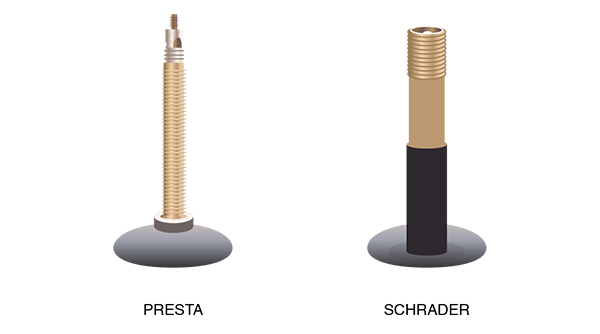
Of course, there must be a way for the air from the pump to get inside your tire. More specifically, inside the inner tube. Sticking out from bike wheels everywhere, there are tire valves. These valves are connected to the inner tube which inflates inside the tire to give it its pressure.
When we’re talking about tire pressure, we’re talking about the pressure (in psi) that is pumped into the inner tube via the valve.
Crucially, there are two main valve types for cycling inner tubes: Presta and Schrader.
Presta valves are the longer and thinner valves more often seen sticking out of road bike tires. These valves can hold higher tire pressure and seal more tightly than Schrader valves.
Learn more: Presta Valves Explained
You can find Presta valves on almost all performance bikes such as road bikes, cyclocross bikes, gravel bikes, and many mountain bikes.
Compared to Schrader valves, Presta valves typically perform better in the long run and don’t degrade as quickly.
Schrader valves are actually different in their construction from Presta valves, as they are pneumatic (holding pressurized air or gas) valves. You can find Schrader valves on more than just bikes. Schrader valves are the type that can be found on cars, motorcycles, buses, and more.
On bikes, you can typically find Schrader valves on non-performance bikes such as hybrids, low-end mountain bikes, and kids’ bikes. You will need a Schrader-specific attachment on your floor pump in order to connect to a Schrader valve which is significantly wider than a Presta valve.
You can actually find Schrader pumps outside of bike shops, for example, at gas stations. These are the same valves used to pump up car tires.
See more: Best Bike Pumps
What to Keep in Mind?
Bicycle tire pressure can be tricky to measure when you don’t have the right tools. The “thumb test,” or pressing the tire with your thumb, is not a reliable way to measure your tire pressure. No matter how experienced you may be.
You can find digital tire pressure gauges that you can throw in your saddlebag or back pocket. They can save you lots of time and stress if you suspect a puncture.
Never go outside a tire’s recommended pressures, which you can find printed on the sidewall. Those numbers are there for a reason, and a tire failure can be quite dangerous.
Valve stems can wear over time, and Presta valves especially are easily bent. So make sure to secure the pump attachment straight onto the valve when pumping up your tires. If that valve core bends or breaks, the air can be released and you’ll end up with a flat tire.
When repairing a flat tire, check to make sure that the inner tube is not “pinched”. That means that it should not be between the tire and the rim. The inner tube should be completely inside the tire and inside the rim. If the tube is pinched, then the tube can pop while pumping up your tire as the tube gets squeezed against the sharp part of the rim.
Related: Best Bike Tubes
Frequently Asked Questions
What PSI should my bike tires be?
The ideal psi for bike tires depends on many factors such as the type of bike and tire, the rider weight, riding conditions, and width of the tire.
For road bikes, a range of 80-100 psi is suitable for almost all types of tires, with heavier riders and wider tires being made ideal with more pressure. Lighter riders and narrower tires operate best at lower pressures such as 80-90 psi.
Off-road tires, such as those found on mountain bikes and cyclocross bikes, are ideal at much lower pressures, such as 20-30 psi. The same principles apply when it comes to minor adjustments in tire pressure. Tubeless and tubular tires are also best at lower pressures, whereas clinchers should be run at slightly higher pressures.
What happens if you put too much air in your bike tires?
If you forgo the recommended psi for bike tires and overinflate your tires, you run the risk of poor traction, excessive tire wear, and catastrophic failure. At best, overinflated tires will decrease your cornering and handling ability whilst also increasing your rolling resistance. They will compromise the comfort of your ride, creating a stiff and bumpy experience over rough terrain.
At worst, overinflated tires are set up for catastrophic failure, which can come in the form of either a puncture or tire blow out. A puncture can ruin the flow of your ride, but it should take only a few minutes to fix. However, a tire blowout can ruin your tire, wheel, and bike, and it can even cause you to crash. Always stick with the manufacturer’s recommended tire pressure and do not put too much air in your tires.
How do I know if my bike tires have enough air?
All bike tires have a range of air pressure (measured in psi) printed on their sidewalls. For a road bike tire, for example, that range may be 80-100 psi. You should always ensure that your tires are pumped up to the minimum recommended psi, and you can check this with either a floor pump or a digital pressure gauge.
Though some riders swear by the “thumb test,” this is an extremely unreliable way to check your tire pressure, and you should always use a mechanical or electronic gauge instead.
Should I pump my bike tires to max psi?
The max psi is not necessarily the ideal tire pressure for bicycles, as this can compromise handling and efficiency, especially on bumpy roads or in wet conditions. Heavier riders on narrower tires operate best with higher tire pressures, though the maximum psi is rarely ideal.
How often should you pump up bike tires?
In order to maintain the ideal psi for bike tires, you should pump up your tires at least once per week. Road bike tires (which hold higher pressures) should be pumped up the most often at 1-2 times per week, whereas off-road tires such as mountain bike tires can be pumped up once every two weeks.
Remember that these are the minimum requirements for maintaining the ideal tire pressure, and it doesn’t hurt to check more often. Pumping up your tires takes less than a minute, and it could save you getting stuck at the side of the road with a flat tire.

